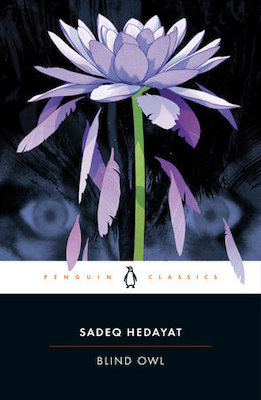During a recent trip to Spokane, I went to Auntie’s Bookstore to buy a novel to read on the train. I searched for a half-hour, or maybe a whole hour, but I ended up buying the first novel that caught my eye when I was in the store only for a minute. It was Blind Owl by Iranian writer Sadeq Hedayat. I never heard of him, but in the novel—more precisely novella—he caught my attention by the open paragraph, which compared stories to termites that bore their way to the soul. After that beginning, how could I ignore the rest of the story? I read it on the train, and I read it again a week ago to remind me of the plot. It’s a chilling story that described two murders from the killer’s point of view.
Or was it two crimes?
Maybe there was no murder, just a deranged mind telling a disillusive fantasy. I read unreliable narrations before, but the unreliable narrator in Blind Owl…well, let me put it this: I don’t trust anything he says! Usually, in unreliable narration, you feel the story is mostly true, but in Blind Owl, we have to entertain the option that nothing is true, all is a figment of his troubled soul.
There are two timeframes in this story. We begin in modern Iran, where he—he never tell us his name—lives alone in a clay house at the edge of the city. He is a painter of pen cases, which he ships to his uncle in India to sell for him. The paintings share a motif: an old man dress as a yogi relaxes beneath a cypress tree as a young woman, dressed in all black, pours water from a water lily for him. One day, a woman visits him—the woman in the painting?—and he kills her with poison.
After killing her, he buries her with the help of an old man who digs graves for his living. While digging her grave, the old man found an earthen jar, an ancient artifact from the city of Rey. Back in his house, the narrator uses the jar to transport himself to the ancient city of Rey, where he finds himself married to an unfaithful woman. Or is she unfaithful? She might be a victim of calumny. But he believes she is cheating on him, so he kills her with a knife, in one of the bloodiest passages I had ever read.
In its 87 pages, Blind Owl is a dense novella.I was surprised by how much information it conveys to us in such a short, concise, and succinct manner. Two timelines! Detailed descriptions of the characters! The internal toil he faces as an opium addict and a deranged young man!
Oh yes, opium!
Is it the cause that inspires the visions that he suffers from? I believe it because something is distorting his grasp on reality. Why not opium? It’s as likely as anything. How much in this novella really happens and how much is drug-fueled hallucinations? Do you see why I don’t trust him? Why do I doubt everything he says? What is true? What is false? There is truth here, but I can’t offer you any clue where it is or how to interpret it.
Death is the main theme. That shouldn’t surprise you since the novella details two murders, but it so much more than death. Whose death are we talking about? He’s obsessed with his own death, because he longs the leave this “vulgar” earth behind. But it is also about sexual frustration and family rivalry. As a young man living in Rey, he’s cared for by his wet nurse, but he yearns for a connection with his uncle (or he is his father) living in India. Everything blends together like oil and water—that is, it does not—but it works, and everything leads to death.
Sadeq or Sadegh Hedayat was born on February 17, 1903, in Tehran. As a young man, he studied engineering in Belgium, but he switched it to architecture in France. Later, he switched it to dentistry. He left college without a degree. Back in Iran, he focused on his literary career. I said that I haven’t heard of him, but the fault is mine, not his, for he had an industrious career. That said, Blind Owl, which he wrote in Bombay, is his most famous work.
Like Silvia Plath, Hedayat committed suicide; he even chose the same method, gas inhalation. That was in Paris on April 9, 1951. When I read that, on the train, I almost didn’t read the novel. Reading The Bell Jar was depress me so much that I didn’t want to read another suicidal manifesto. But Blind Owl is not a manifesto as The Bell Jar is. That not is to stay the novels share nothing. Not only are they short novels, but they both also drive us into exploring a strange, disturbing mind.
In Iran, the current government has banned Hedayat in 2006. Despite this, you can find his work in bookstores. I mention this because a library in Llano County, Texas, is threatened with closure because of politics. What started with books being banned from school libraries has moved to a county library system. Can we say a slippery sloop?
Blind Owl is a short but dense novella, and one I urge you to check out. I read the novel twice, and I know I read it again. It’s packed with metaphors and allusions, and I know I find new things to love and ponder about every time I read it.

